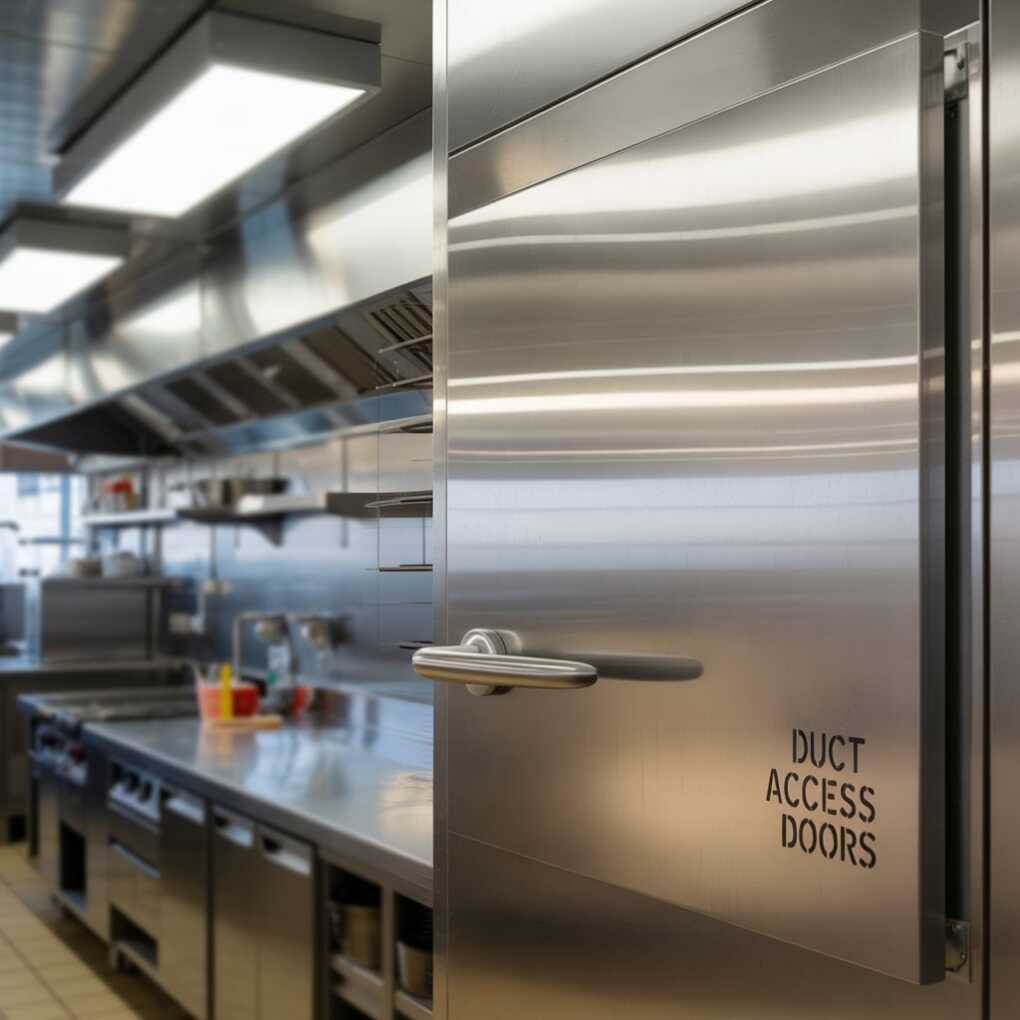In a busy commercial kitchen, efficiency and cleanliness are essential, particularly for ventilation ductwork. Neglected ducts can cause grease buildup, reducing airflow and air quality, which increases fire risks and disrupts operations. Failure to keep these systems in tip-top shape can also lead to hefty fines from regulatory agencies.
The solution? Duct access doors. These installations simplify the cleaning and maintenance of hard-to-reach ventilation systems, helping to remove grease buildup and improve airflow. This proactive approach enhances air quality, reduces the risk of fire, and contributes to a safer, more efficient kitchen.
This article explores the benefits of duct access doors in kitchen design and management, highlighting their role in transforming potential problems into reliable solutions that ensure safety, boost efficiency, and support regulatory compliance.

The Risks of Poor Kitchen Ventilation
Proper ventilation is crucial for a commercial kitchen’s safety, health, and efficiency. Poor ventilation raises fire risks due to grease buildup in exhaust ducts, harms air quality, and reduces staff productivity, potentially leading to long-term health issues.
Neglected systems can also drive-up energy costs and lead to frequent repairs and fines for non-compliance with health and fire regulations. Thus, adequate ventilation is essential for the kitchen’s safety and success.
Duct Access Doors: Your Kitchen’s Best Friend
Duct access doors are important for good ventilation in busy commercial kitchens. These strong openings in your ductwork let maintenance staff reach and check hard-to-access areas without the costly need to take things apart. You can choose from unique designs, like hinged and cam-lock models, which are built to prevent air leaks and hold grease.
One key benefit of duct access doors is that they can transform your cleaning routine. They allow cleaning staff to reach tough spots in the ducts, saving personnel the time and effort for thorough cleaning.
Regular access also encourages inspections, making spotting grease buildup easier and keeping health and safety standards.
Duct access doors also improve the efficiency of your kitchen ventilation system. Clean airflow lowers energy use and reduces utility costs. Additionally, these doors help eliminate smoke, odors, and other pollutants, improving air quality for staff and customers. Installing these in your kitchen can boost efficiency and safety, creating a healthier environment for everyone.
Choosing and Installing the Right Duct Access Doors
Effective duct access doors must be the right type, placed correctly, and installed properly, prioritizing safety and compliance.
When selecting duct access doors, consider the following:
1. Material: Match the door material with existing ductwork (e.g., galvanized steel with galvanized ducts) to prevent corrosion.
2. Seal: Choose doors with strong seals to prevent air leaks and ensure efficiency.
3. Size and Placement: Ensure the access door is easily reachable for cleaning and inspections. Its placement is crucial for effective maintenance. There may be times that access door customization for specific duct sizes is necessary. Paying attention to these details will enhance performance.
4. Fire Resistance: If ducts go through fire-rated barriers, select doors that meet fire-resistance standards.
5. Compliance: Ensure compliance with industry standards like NFPA 96 for optimum performance.
Strategic Placement for Maximum Impact
Position access doors wisely, such as near duct bends where residues accumulate. Install doors at 10 to 12-feet intervals for convenient access in straight sections. Remember to place doors near critical components like fans and filters for easier inspection and maintenance.
Professional Installation Is Key
Proper installation is essential for performance. An airtight seal prevents leaks, and correct fastening ensures durability. Follow manufacturer guidelines for installation to support warranties and functionality in regular and emergency situations.
Long-Term Benefits for Your Business
Duct access doors offer significant benefits beyond cleaning. They help lower fire risks by allowing regular maintenance of flammable grease in ductwork, creating a safer environment for kitchen staff.
Moreover, these doors also ensure compliance with regulations like NFPA 96, helping businesses avoid fines and shutdowns. By following fire safety regulations, businesses can access better insurance options.
Additionally, these doors contribute to reduced operational costs by extending the lifespan of kitchen equipment. They ease ventilation system maintenance, enhance airflow, and decrease the strain on HVAC systems, lowering energy and maintenance expenses.
A well-maintained ventilation system boosts a kitchen’s reputation, builds customer trust, and encourages growth through positive referrals. Investing in duct access doors is a wise and practical long-term move in commercial kitchens.
Focus on Kitchen Safety and Efficiency
A good ventilation system is essential for safety and operations in a commercial kitchen. Neglecting maintenance can lead to fires, poor air quality, and fines.
Installing duct access doors simplifies cleaning, improves airflow, and enhances fire safety. Proper placement maximizes these benefits.
Commercial kitchen designers and managers should focus on quality duct access doors in new builds and upgrades. This investment boosts business growth through a safe, efficient kitchen, leading to longer-lasting equipment, reduced costs, regulatory compliance, and a better reputation.
